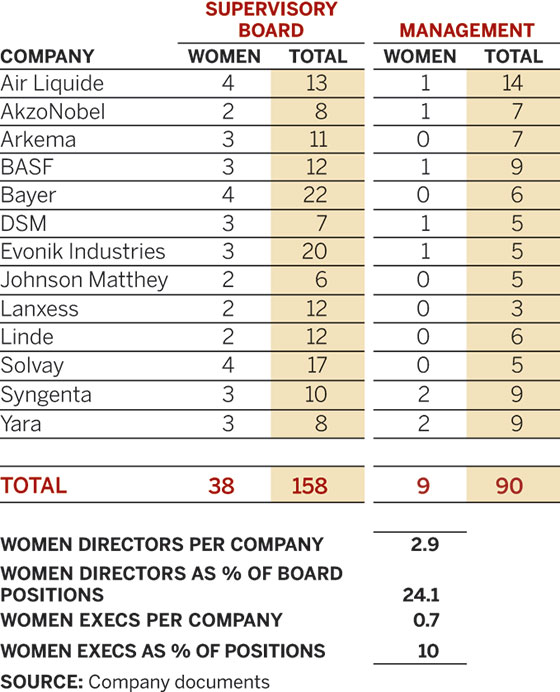Advertisement
Grab your lab coat. Let's get started
Welcome!
Welcome!
Create an account below to get 6 C&EN articles per month, receive newsletters and more - all free.
It seems this is your first time logging in online. Please enter the following information to continue.
As an ACS member you automatically get access to this site. All we need is few more details to create your reading experience.
Not you? Sign in with a different account.
Not you? Sign in with a different account.
ERROR 1
ERROR 1
ERROR 2
ERROR 2
ERROR 2
ERROR 2
ERROR 2
Password and Confirm password must match.
If you have an ACS member number, please enter it here so we can link this account to your membership. (optional)
ERROR 2
ACS values your privacy. By submitting your information, you are gaining access to C&EN and subscribing to our weekly newsletter. We use the information you provide to make your reading experience better, and we will never sell your data to third party members.
Careers
Women Chemists
by Rudy M. Baum, Editor-in-chief
September 17, 2007
| A version of this story appeared in
Volume 85, Issue 38
This week's issue of C&EN features three stories that concern women in chemistry. The cover story is an interview with Marye Anne Fox, chancellor of the University of California, San Diego, and one of the most successful and influential women in science and academia today.
The "C&EN Talks With" feature in the Business Department is a profile of Anne Noonan, president of Chemtura's $1.8 billion-per-year polymer additives business. And the lead ACS News story, "Demographics of Chemistry," contains illuminating data on the increasing number of U.S. women receiving bachelor's, master's, and Ph.D.'s in chemistry.
The halting progress of women in the chemical enterprise is a topic that C&EN has focused on for many years. Former Editor-in-Chief Madeleine Jacobs (now ACS executive director and CEO) instituted C&EN's annual "Women in Academia" and "Women in Industry" scorecards, which track women's progress in the upper echelons of these male-dominated worlds. Editor-at-Large Michael Heylin (who preceded Jacobs as editor-in-chief) has charted that progress in the many statistical analyses he has written for the magazine.
Heylin wrote this week's ACS News story, which looks at data compiled by the society's Committee on Professional Training (CPT) over the past three years. CPT reports on the gender, race, ethnicity, and citizenship of new chemistry graduates. For the class of 2006, women earned 51.9% of the bachelor's degrees in chemistry, 48.6% of the master's degrees, and 35.8% of the Ph.D.s—all increases over the percentages for the class of 2004.
Nevertheless, C&EN's most recent survey of women in academia (Dec. 18, 2006, page 58) is titled "Women Faculty Gain Little Ground," by Associate Editor Corinne Marasco. The survey looks at the top 50 U.S. research universities. "Despite an increase in the number who choose careers in science and engineering, women continue to be significantly underrepresented among university chemistry faculty," Marasco writes.
The situation in industry is not much different. Although Noonan told C&EN Assistant Managing Editor Michael McCoy that the subject of gender doesn't interest her much, she does acknowledge that, "I only notice it when I go to the Greenbrier," a reference to the resort where the American Chemistry Council holds its annual meeting. The gathering of chemical industry executives is primarily male.
In his interview with Fox, C&EN News Editor William Schulz asked the chancellor about the lack of progress of women in chemistry at top universities. "You correctly capture the challenge we face in recruiting women to academic positions, whether it's faculty or administration," Fox replied. "I can't tell you why that is."
It occurred to me that C&EN has four women—Senior Correspondent Ann Thayer, Associate Editors Susan Morrissey and Bethany Halford, and Assistant Editor Carmen Drahl—on its staff with Ph.D.s in chemistry from top U.S. research universities, and I decided to ask them whether they had considered academic careers and, if not, why. Their answers are revealing.
Three of the four are married to Ph.D. chemists and the other to an M.D. Thayer and Halford both mentioned the "two-career problem" as especially acute in academe. Morrissey says she never was interested in heading a research group, and Drahl says she doesn't like having to focus on a narrow area of chemistry.
Importantly, all four referred in one way or another to the "academic lifestyle" as a significant negative. Drahl says that, as a writer, she can "do some of what a tenured professor does without eight years of backbreaking labor as a postdoc and an assistant professor."
Halford was blunt. "I never considered a career in academia. It is a ton of work with very little payoff. It is especially hard for a woman of childbearing age, but it is hard for anybody." Fewer women than men embark on such a career, she says, because "I think women are just wiser than many men when they evaluate a career in academia."
Such sentiments are not a good harbinger for the future of chemistry.
Thanks for reading.
Views expressed on this page are those of the author and not necessarily those of ACS.



Join the conversation
Contact the reporter
Submit a Letter to the Editor for publication
Engage with us on Twitter